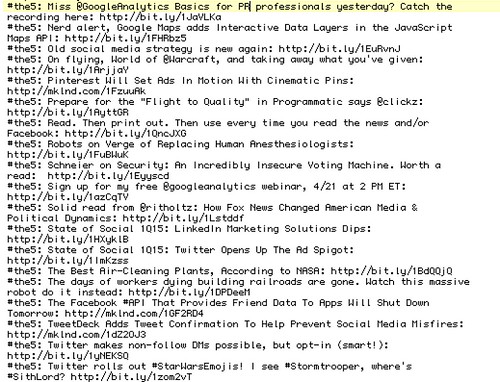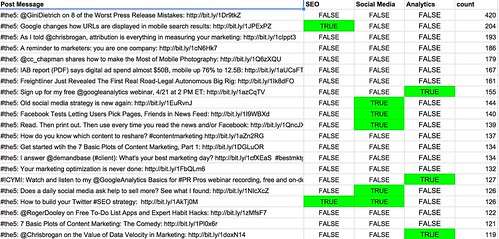Hashtagging is often cited by marketers as a way to build grassroots attention towards a particular theme, type of content, or movement. In reality, most hashtags created by marketers tend to be ignored. Consumers and audiences use their own when sharing content, or in many cases simply use none at all, especially on Facebook.
So, what use are hashtags for marketers if the audience isn’t using them the way we’d hope? Should we just abandon them?
Not at all, if you want to do painless content marketing analytics. Hashtags are your key to content marketing analytics sanity. Why? Take a look at your recent social media shares. How easy is it to determine what each share is about?
When you look at the above wall of text, there’s no obvious way to instantly determine what many of the social posts are about. You’d have to read them carefully and even then, categorizing them would be a difficult, laborious effort. If you’re trying to be agile and nimble in your content marketing, manually sorting the above list would soak up hours each day.
Suppose you used hashtags in your content to denote post about #SEO or #Pinterest or #analytics. You could quickly categorize your posts by their topics:
Above, you can also see that I’ve analyzed each post to determine the number of clicks each post has gotten. Now, by using a logical taxonomy, I can see if some topics get more clicks than others. (premium subscribers to my newsletter will learn how to construct that magical spreadsheet in this week’s issus)
This is how we make hashtags more useful, even if no one else clicks on them, shares them, or uses them in conjunction with our content. Hashtags, combined with some basic data analysis, can tell us what topics and content our audiences actually care about, and the process takes seconds or minutes instead of hours or days. Use them to track all your content!
You might also enjoy:
- Mind Readings: You Need Passwords for Life in the Age of Generative AI Fraud
- Almost Timely News, January 28, 2024: Copyright Must NEVER Apply to AI-Made Works
- Mind Readings: Generative AI and Addition vs Substitution of Jobs
- Mind Readings: Most Analytics Data is Wasted
- Mind Readings: Hacking Social Media Algorithms
Want to read more like this from Christopher Penn? Get updates here:
 Take my Generative AI for Marketers course! |




Leave a Reply